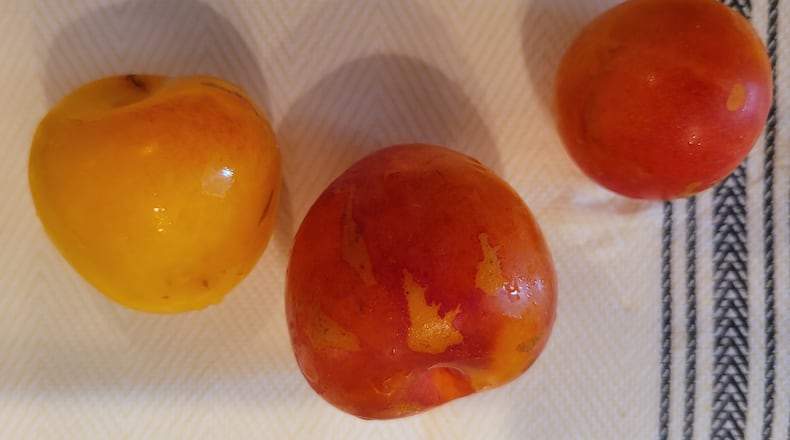Supermarket plums also tend to be very large. Bigger is better in the eyes of many shoppers, but not for plums. Our local plums are smaller than those in supermarkets, and juicier and sweeter.
Local plums have been available in Oxford’s Farmers Market. Several varieties can be found, but even here in the Farmers Market they are overshadowed by other fruit such as cherries, berries and especially apples. The early varieties here have been yellow and red rather than the more familiar purple color that people associate with plums.
Production of fresh plums has also plummeted because an increasing share of production is allocated to dried plums, in other words prunes. Marketers have discovered that Americans prefer the name dried plum instead of prune.
Many species of plums are found around the world. The two commercially important are commonly called European and Japanese.
In the United States, most prunes (dried plums) come from European plums. Most fresh plums are Japanese.
Another challenge for plums is limited usefulness in baking sweet desserts. The most famous “plum” dessert — the plum pudding served in Britain at Christmas — doesn’t actually contain plums. What was once known in Britain as a plum is actually a raisin.
Plums get virtually no mention in the cookbooks I regularly consult. The principal uses seem to be cooking into jam, distilling into alcohol, or drying into prunes.
The most-frequently Googled The New York Times recipe is for a plum torte by Marian Burros in 1983. The recipe was published annually in the newspaper through the 1980s, until the food editor tired of it and relegated it to the internet.
Cream 3/4 cup sugar and 1/2 cup sweet butter in a bowl. Add 1 cup unbleached flour, 1 teaspoon baking powder, a pinch of salt, and 2 eggs, beat well, and spoon the batter into a springform pan. A tablespoon of sour cream or creme fraiche can be added to the batter.
Cut 12 small plums in half, remove the pits, and place atop the batter, skin side up. Or slice the plums in pieces before placing on the batter.
Sprinkle with 1 teaspoon cinnamon. Bake at 350 degrees for 1 hour. Cool on a rack before removing from the pan.
Best bet is to save the baking for other fruit. The small plums from local growers are sweet enough to pop in your mouth and eat on the spot in one bite. All you need is a discrete way to dispose of the pit.
MOON Co-op is Oxford’s consumer-owned full-service grocery, featuring natural, local, organic, sustainable, and Earth-friendly products. The store, located at 516 S. Locust St. in Oxford, is open to the public every day. Find it online at www.mooncoop.coop.
About the Author
